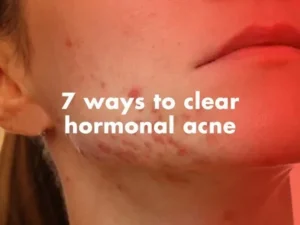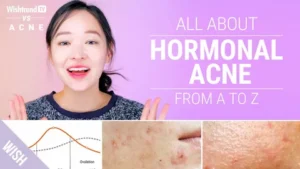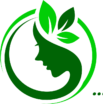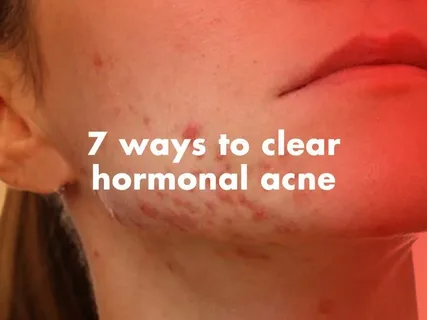Is Hormonal Acne Getting Worse in Your 30s? How to Stop Flare-Ups Fast
Introduction:
When Acne Refuses to Act Its Age
You thought breakouts were a teenage thing. But here you are, in your 30s battling angry red spots along your jawline, painful cysts on your chin, and relentless flare-ups that don’t seem to respect your adult status. If you’re wondering why hormonal acne is still haunting you or even getting worse, this post is for you.
Hormonal acne in your 30s is real, and it’s far more common than you think. Unlike the whiteheads and blackheads of your teens, adult acne can be deeper, more persistent, and often more emotionally exhausting. But the good news? You don’t have to live with it. Understanding what’s causing it and how to treat it effectively, can be the first step to clearer, calmer skin.
Let’s unpack what’s really going on, what science and dermatologists are saying, and how to stop those annoying breakouts fast.
. Wha t Causes Hormonal Acne in Your 30s?
t Causes Hormonal Acne in Your 30s?
Before diving into treatments, let’s understand the root causes. Hormonal acne is triggered by fluctuations in androgens, especially testosterone which stimulate excess sebum (oil) production. This creates the perfect environment for clogged pores and inflammation.
In your 30s, several factors can trigger these fluctuations(hormonal acne):
- Menstrual cycle changes (especially as perimenopause approaches)
- Discontinuing birth control or switching contraceptives
- Increased stress levels (raising cortisol, which affects other hormones)
- Dietary choices (like high sugar or dairy intake)
- Pregnancy or postpartum shifts
Unlike teenage acne that centers on the forehead and nose, adult hormonal acne usually shows up around the chin, jawline, and lower cheeks.
: Best Acne Treatment in 2025
Finding the best acne treatment today means striking a balance between topical science and internal hormone balance. Below is a comparative table showing current top treatments:
| Treatment Type | Examples | Works Best For | Considerations |
|---|---|---|---|
| Topical Retinoids | Adapalene, Tretinoin | Clogged pores, skin turnover | Can cause initial purging |
| Benzoyl Peroxide | PanOxyl, Clearasil | Bacteria-killing | May dry or irritate sensitive skin |
| Spironolactone | Prescription only | Hormonal regulation | Only for women, needs monitoring |
| Clascoterone (Winlevi) | Topical anti-androgen | Jawline and cheek acne | New FDA-approved option |
| Salicylic Acid | Paula’s Choice, Neutrogena | Exfoliation, blackheads | Gentle and effective |
| Isotretinoin (Accutane) | Oral prescription | Severe, scarring acne | Requires close supervision |
Each has its strengths. But choosing the right one depends on your skin type, acne severity, and medical history. More dermatologists are now recommending Clascoterone (Winlevi) as a revolutionary topical treatment for adult women—it targets hormones at the skin level, minimizing side effects (Cleveland Clinic).
Best Hormonal Acne Treatment Types

Topical Retinoids—Your First Line of Defense
When it comes to tackling clogged pores, boosting cell turnover, and smoothing out skin texture, topical retinoids are often considered the gold standard in acne treatment, especially for adult hormonal acne.
What Are Retinoids?
Retinoids are vitamin A derivatives that work by increasing skin cell turnover and preventing dead cells from clogging pores. They also reduce inflammation and help fade post-hormonal acne marks.
Common Types:
-
Adapalene (Differin): Over-the-counter, gentler than prescription versions.
-
Tretinoin (Retin-A): Prescription-strength, more potent.
-
Tazarotene: Stronger and often used for more resistant acne.
Benefits of Topical Retinoids:
-
Unclog pores and prevent new breakouts
-
Reduce the appearance of acne scars and hyperpigmentation
-
Improve overall skin texture and tone
-
Work synergistically with other treatments like benzoyl peroxide
How to Use Them Safely:
-
Start 2–3 times per week to build tolerance
-
Always apply at night (retinoids are photosensitive)
-
Use a pea-sized amount for the entire face
-
Moisturize generously to reduce dryness
-
Don’t combine with harsh exfoliants (like AHAs or scrubs) in the same routine
Possible Side Effects:
-
Peeling or dryness in the first few weeks (commonly called the “retinization period”)
-
Temporary purging as deeper acne surfaces
-
Sun sensitivity (always pair with SPF)
Pro Tip: Pairing adapalene with benzoyl peroxide in alternating routines can address both the causes of acne: clogged pores and bacteria. This combo is particularly effective for hormonal acne when used consistently over 8–12 weeks.
Benzoyl Peroxide—Fighting Bacteria at the Source
While hormonal shifts cause the oil buildup, benzoyl peroxide goes after the bacteria that make acne worse. It’s an over-the-counter staple that dermatologists continue to recommend for its proven effectiveness.
How It Works:
-
Kills acne-causing bacteria (Cutibacterium acnes)
-
Reduces inflammation and redness
-
Helps prevent new breakouts when used consistently
Forms Available:
-
Creams
-
Gels
-
Cleansers
-
Spot treatments
Strengths Range From 2.5% to 10%, but studies show that even lower concentrations (like 2.5%) are as effective as higher ones in treating hormonal acne , with fewer side effects.
How to Use Benzoyl Peroxide:
-
Start with 2.5% strength once daily
-
Apply to clean, dry skin
-
Let absorb before layering moisturizers or sunscreens
-
Avoid using with retinoids simultaneously (alternate days or routines)
Things to Watch For:
-
Skin dryness or peeling (especially in the first 2 weeks)
-
Fabric bleaching (towels and pillowcases)
-
Sun sensitivity, always wear SPF
Pro Tip: If you’re using benzoyl peroxide alongside a retinoid, apply them at different times, one in the morning, one at night to reduce irritation and boost results.
Spironolactone—Targeting Hormones from Within
If your acne seems to flare up around your period or gets worse with stress, spironolactone might be the missing piece in your treatment plan. Unlike topical products, this oral medication works from the inside to block excess androgens, the hormones that often drive stubborn hormonal acne in adult women.
What Is Spironolactone?
Originally developed as a diuretic to treat high blood pressure, spironolactone has a secondary benefit: it reduces the activity of androgens (male hormones like testosterone), which can overstimulate oil glands in the skin.
How It Works for hormonal acne:
-
Decreases oil production
-
Reduces hormonal fluctuations linked to breakouts
-
Lowers inflammation and cyst formation
Who Should Consider It?
-
Women with acne that worsens around the jawline, chin, or neck
-
People whose breakouts align with their menstrual cycle
-
Those who have tried topicals but still experience persistent flare-ups
Important Notes:
-
Not prescribed for men due to hormonal side effects
-
Requires a prescription and regular blood tests to monitor potassium levels
-
Results typically appear after 8–12 weeks of consistent use
Side Effects May Include:
-
Increased urination
-
Breast tenderness
-
Changes in menstrual cycle
-
Fatigue or dizziness in rare cases
Pro Tip: Many dermatologists combine spironolactone with topical treatments like retinoids or Winlevi to address both internal and external triggers for hormonal acne. It’s especially helpful for women in their 30s whose acne is resistant to over-the-counter treatments.
As noted by the American Academy of Dermatology, spironolactone is becoming a first-choice oral therapy for adult female hormonal acne that doesn’t respond to conventional methods.
Clascoterone (Winlevi)—The First Topical Anti-Androgen for Acne 🎯
For adult hormonal acne that doesn’t respond to classic topicals or internal treatments, clascoterone cream 1% (Winlevi) offers a novel, targeted approach. Approved in August 2020 as the first topical androgen receptor inhibitor, it works by blocking hormone activity directly in the skin—without systemic side effects
How It Works
Clascoterone competes with dihydrotestosterone (DHT) and testosterone at the androgen receptors within sebaceous glands and follicles. By doing so, it reduces sebum production, inflammation, and the downstream processes that lead to breakouts MDEdge.
Clinical Effectiveness
-
Two large Phase III trials involving roughly 1,440 participants (ages 9–58) showed ~19–21% treatment success, defined as clear or almost clear skin with at least a 2‑grade improvement in acne severity—versus only ~7–9% for placebo after 12 weeks FDA Accessdata+9European Medical Journal+9Wikipedia+9.
-
It performed numerically better than tretinoin in early pilot studies, with less irritation and faster lesion reduction Veterans Affairs.
-
Long-term and real‑world data (Canada, May 2023–2024) supports its efficacy across all skin types, severities, and genders—with good tolerance and maintenance benefits in preventing relapse MDEdge+13Dove Medical Press+13JCAD+13.
Quick Comparison of Clascoterone vs. Spironolactone (and other options)
| Feature | Clascoterone (Winlevi) | Spironolactone |
|---|---|---|
| Application | Topical cream, twice daily | Oral tablet, daily |
| Mechanism | Blocks androgens in the skin | Blocks systemic androgen activity |
| Side Effects | Mild local irritation (5–7% rate) | Hormonal effects, menstrual changes |
| Systemic Absorption | Minimal; no widespread hormonal impact | Full-body effects |
| Use in Males | Approved and safe | Not recommended (anti-androgenic) |
| FDA Approval | August 2020 | Off-label use for acne |
| Onset of Action | ~12 weeks in clinical trials | Often 8–12 weeks |
| Price (USA, tube/supply) | Higher (~$580 per tube) NCBI+13practicaldermatology.com+13JAMA Network+13FDA Accessdata+12Wikipedia+12MDEdge+12drugs.com+14AAFP+14MDEdge+14FDA AccessdataDove Medical PressWikipedia+2JAMA Network+2JCAD+2 | Lower (~$10/month generic) |
Who Benefits Most?
-
Adults with jawline and cheek breakouts that persist despite topical treatments.
-
Those who prefer a non-oral, localized approach targeting hormonal acne.
-
Patients who want anti-androgen effects without systemic risks or laboratory monitoring.
Implementation Tips:
-
Apply a thin layer twice daily to hormonal acne-affected areas only.
-
Avoid using with other irritants, especially abrasive cleansers or strong actives, until your skin adjusts.
-
Watch for mild redness or irritation during the first few weeks; these reactions tend to resolve over time.
-
If breakouts return after isotretinoin or other intensive treatments, clascoterone can be a maintenance option to help prevent relapse.
Pro Tip: Many dermatologists now add clascoterone on top of routines that include retinoids or benzoyl peroxide to address both internal hormonal acne triggers and external inflammation simultaneously.
Salicylic Acid:
When it comes to over-the-counter ingredients that deliver consistent results, salicylic acid stands as a tried-and-true favorite, especially for adult and hormonal acne-prone skin that needs gentle yet effective exfoliation.
What Is Salicylic Acid?
Salicylic acid is a beta hydroxy acid (BHA) derived from willow bark. It’s oil-soluble, meaning it can penetrate deep into the pores, dissolve excess sebum, and break down the dead skin cells that clog follicles.
How It Works:
-
Unclogs pores and prevents new blackheads or whiteheads
-
Reduces redness and inflammation associated with active breakouts
-
Minimizes oil without over-drying skin
-
Gently exfoliates the surface to improve texture and fade post-acne marks
Best For:
-
Mild to moderate acne (especially non-inflammatory types like blackheads and whiteheads)
-
Oily or combination skin types
-
People with sensitive skin who can’t tolerate retinoids or benzoyl peroxide
Common Formulations:
-
Cleansers
-
Toners
-
Serums
-
Spot treatments
-
Face pads and masks
How to Use Salicylic Acid in Your Skincare Routine:
-
Start with a 0.5%–2% concentration (most OTC products fall in this range)
-
Use a gentle cleanser with salicylic acid in the morning
-
Apply a leave-on product (toner or serum) only once daily to begin
-
Follow with moisturizer and broad-spectrum sunscreen
Avoid mixing with:
-
Strong exfoliants (glycolic acid, lactic acid)
-
Retinoids (unless alternating routines)
-
Harsh physical scrubs
Key Benefits for Hormonal Acne in Your 30s:
-
Controls mid-day oiliness without stripping the skin
-
Helps fade hyperpigmentation from past flare-ups
-
Pairs well with hormonal acne treatments like Winlevi or spironolactone
| Benefit | Salicylic Acid |
|---|---|
| Skin type suitability | Oily, combo, sensitive |
| Exfoliation type | Chemical (BHA) |
| Anti-inflammatory effect | Yes |
| Works for blackheads? | Yes |
| Safe during pregnancy? | In low concentrations (consult doctor) |
| Typical strength range | 0.5% to 2% |
Pro Tip: If your skin gets irritated easily while treating hormonal acne , look for encapsulated salicylic acid or formulas with calming ingredients like niacinamide or green tea. These help buffer the exfoliating action without sacrificing effectiveness.
As dermatologists from the American Academy of Dermatology note, consistent use of salicylic acid on hormonal acne, can lead to smoother, clearer skin within 4–6 weeks—especially when combined with a solid routine that supports skin barrier repair.
Isotretinoin (Accutane)—The Heavy Hitter for Severe Acne
If you’ve tried every topical cream, serum, and oral medication with little success, isotretinoin—commonly known by its brand name Accutane might be your final frontier. Though it’s often seen as a last resort, isotretinoin is also one of the most effective treatments for severe or cystic hormonal acne, especially in adults whose skin has stopped responding to anything else.
What Is Isotretinoin?
Isotretinoin is a powerful oral retinoid derived from vitamin A. It works by shrinking the size of sebaceous (oil) glands, dramatically reducing sebum production, which in turn minimizes clogged pores, inflammation, and acne-causing bacteria.
How It Works:
-
Decreases oil production by up to 90%
-
Normalizes skin cell shedding and turnover
-
Reduces inflammation at a cellular level
-
Permanently alters acne-prone skin physiology in many cases
Best Suited For:
-
Moderate to severe nodulocystic acne
-
Acne that leaves scars or dark marks
-
Individuals who’ve failed other prescription treatments like spironolactone or retinoids
-
Patients willing to undergo medical monitoring
What to Expect During Treatment:
-
A typical course lasts 4 to 6 months, with monthly dosage adjustments
-
You’ll likely experience dry skin, dry lips, and increased sun sensitivity
-
Blood tests are required to monitor liver function and cholesterol levels
-
For women, strict birth control protocols are mandatory due to risk of birth defects (iPLEDGE program in the U.S.)
Isotretinoin Side Effects:
-
Common: Dry lips, dry skin, nosebleeds, joint pain
-
Less common: Mood changes, vision disturbances, GI issues
-
Rare: Elevated liver enzymes, triglycerides, or long-term skin sensitivity
Long-Term Impact:
-
Up to 85% of users see permanent or near-permanent clearing after one course
-
Some may need a second course years later, but recurrence is generally less severe
-
Often improves skin texture, reduces oiliness, and minimizes future breakouts
Pro Tip: Hydration is key during treatment, internally and externally. Use fragrance-free moisturizers, healing lip balms, and always wear SPF 50+. Avoid waxing or laser treatments during and for several months after the course.
| Factor | Isotretinoin (Accutane) |
|---|---|
| Type | Oral systemic retinoid |
| Duration | 4–6 months typical course |
| Requires prescription? | Yes (dermatologist only) |
| Monitoring needed? | Yes—monthly bloodwork + pregnancy test |
| Pregnancy safety | Not safe—strict precautions needed |
| Long-term benefits | Often permanent acne resolution |
Is It Worth It?
For those who qualify, isotretinoin can be life-changing—not just for skin clarity, but for self-esteem. However, it’s not for the faint-hearted. It requires patience, consistency, and close collaboration with a dermatologist.
As noted by the American Academy of Dermatology, isotretinoin remains one of the most transformative acne treatments available, but should be reserved for cases where the benefits outweigh the risks.
Skincare Routine for Hormonal Acne
An effective skincare routine is critical, not just for treating acne, but for preventing future flare-ups.
Morning Routine:
- Gentle cleanser with salicylic acid
- Niacinamide serum to reduce inflammation
- Oil-free moisturizer with ceramides
- Broad-spectrum SPF 30+ (acne meds can make skin sun-sensitive)
Evening Routine:
- Double cleanse (oil cleanser + water-based cleanser)
- Topical treatment (retinoid or clascoterone)
- Hydrating serum (like hyaluronic acid)
- Non-comedogenic night cream
Avoid over-exfoliating or mixing too many actives. This can backfire by weakening your skin barrier, making acne worse.
: Diet and Hormonal Acne—What’s the Connection?
Your diet could be feeding your acne.
Studies show that high-glycemic foods (think sugar, white bread, and processed snacks) and dairy products especially skim milk can spike insulin and androgens, which may trigger breakouts. A skin-friendly diet includes:
- Leafy greens
- Omega-3 fatty acids (salmon, walnuts, flaxseed)
- Zinc-rich foods (pumpkin seeds, lentils)
- Green tea (anti-inflammatory)
Cutting down dairy and sugar might not be a cure-all, but many adults report noticeable improvement after a few weeks.
: Fast Remedies for Sudden Acne Flare-Ups
Got an angry zit before a big meeting or wedding? Here’s how to calm things down fast:
- Apply ice to reduce swelling (wrap in a cloth, hold for 1–2 minutes)
- Use a spot treatment with benzoyl peroxide or salicylic acid
- Hydrocolloid patches (like Cosrx or Hero Mighty Patch)
- Don’t pick! It’ll only worsen inflammation and cause scarring
- Apply a sulfur mask for overnight drying
If the pimple is cystic and painful, visit a dermatologist who may inject cortisone, which can shrink it in 24 hours.
: When to See a Dermatologist
If you’ve tried multiple over-the-counter products and your acne keeps returning, it’s time to consult a pro.
See a dermatologist if:
- Your acne is painful, deep, or cystic
- You have post-acne pigmentation or scarring
- Your breakouts worsen around your period
- You’ve tried 3+ products with no result
Prescription treatments like spironolactone or Winlevi may be your best next step.
: Emotional Impact of Acne in Adulthood
Let’s be real, adult acne hurts more than just your skin. It can tank your confidence, disrupt relationships, and even affect job performance. A 2022 study found that over 50% of adults with acne report increased anxiety and self-consciousness.
You’re not alone. Acne is not a result of poor hygiene or lack of effort, it’s biology. And it’s treatable.
Conclusion: Yes, You Can Clear It Up
If hormonal acne is worse in your 30s, don’t panic. It’s more common than ever, and advancements in skincare and medical treatments make it easier than ever to control.
The key is understanding what’s causing your acne, following a gentle yet targeted skincare routine, and knowing when to level up your treatment with help from a professional. Whether you’re exploring Winlevi, spironolactone, or simply cleaning up your skincare lineup, your clearer skin is within reach.
As Harvard Health notes, adult acne is an evolving challenge, but also one with evolving solutions.
So don’t let your breakouts break your spirit. You’ve got the knowledge, the tools, and now the roadmap.


